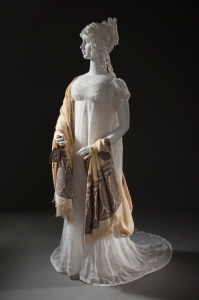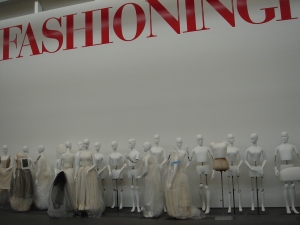In the years, months, and days that led up to the opening of Fashioning Fashion: European Dress in Detail, 1700 – 1915, there was a steady increase of activity in the Costume and Textiles Department as we prepared nearly 100 historic garments for exhibition.
The process of dressing historic garments on mannequins is exacting and time-consuming. Not only must the final presentation accurately portray the fashionable silhouette of the period, the art object must be safely supported for the duration of the exhibition. In doing so, the costume cannot be altered to fit the mannequin; rather it is the mannequin which is padded out to the shape of the garment.
This detailed process begins with the curatorial team researching the date of each piece. Next, the fashionable silhouette for that era is determined and an appropriate mannequin assigned. I say “appropriate mannequin” because we have male and female mannequins that were built to represent each dramatic change in the fashionable silhouette from the eighteenth through early twentieth centuries. For women, corsets, crinolines, and bustles dictated not only idealized waist-to-hip ratios, but also posture and whether “fat” was pushed up, down, in, or out. Period paintings, fashion plates, and photographs were also examined and continually referenced throughout the dressing process.

An example of how period paintings helped us create historically accurate mannequin ensembles. Robert-Jacques Lefèvre, Portrait of a Woman Holding a Pencil and a Drawing Book, c. 1808, gift of Joan Palevsky

Dress, probably India for the Western market, c. 1800, with Shawl, Kashmir, India, c. 1810, Mr. and Mrs. Allan C. Balch Collection
Before the initial “fitting,” a series of measurements were taken from the garment to determine the positioning of the torso, hips, and legs of the mannequin. The dresser then cuts out concentric shapes of batting to slowly build out the mannequin to the shape of the garment. Control-top pantyhose were placed on both the torso and lower portion of the mannequin to hold the pieces of batting in place while providing a smooth safe surface for the object to rest upon. If necessary, prop undergarments were made to complete the silhouette. This part of prepping the mannequin can take several days.

Side view of the mannequin with its torso covered and padded to the shape of a Victorian dress bodice. Rolls of batting are sewn around the hips to create support for the beginnings of a crinoline-shaped understructure
Finally, the costume was carefully placed on its specially prepared mannequin and, after a few minor adjustments, one can step back to enjoy the gratifying moment when the historic garment comes to life.

Period accessories and a paper wig finish the look of a mannequin, now ready for display. Dress, France, c. 1855, with Collar, Europe, 1845–50, and Pair of Undersleeves, Europe or United States, c. 1855
Clarissa Esguerra, Curatorial Assistant, Costume and Textiles









Wow! Great write-up and photos Clarissa. There really is so much that goes on to create an exhibit of this magnitude. There are aspects of the final result that one never even considers, like the creation of the silhouette. I can’t wait to see this exhibition in person.
Absolutely fascinating!
Great article- this was really fascinating! Wish I could see this exhibit in person, but I’m on the other side of the country! 😦
This is so cool. Thanks so much for this post.
In Connecticut and don’t think I will be able to fly to LA but this article, I am learning so much and it all so beautiful…Clarissa, I was once a Curatorical Assistant, it was the best time, thank you so much….
Excited to see the exhibit tomorrow along with my 13 year old daughter! So interesting to see behind the scenes – thank you!
this is wery coll. wery thanks
hello, I am a curator at a museum and loved your mannequins. Do you have a purchased base mannequin that you build off of or are all of your mannequins made in-house? Thanks
Clarissa! I tracked you down through the UGA-FACS article and see that you are doing very well!You have a fabulous job!What fun!Congratulations!
Janet Morley
A wonderful exhibition and i love the paper wigs!
That is a very interesting article, it was great to see pictures of the mannequins in those different stages.
A good view of preparing the exhibition, respect for conservation principles, respect of museology and brilliant insight into the appearance of clothing 19th century
very good design
wonderful thank you!
nice costumes
Thank you
Greetings! Very helpful advice in this particular post!
It’s the little changes which will make the most important changes. Thanks a lot for sharing!